How to propagate chrysanthemum?
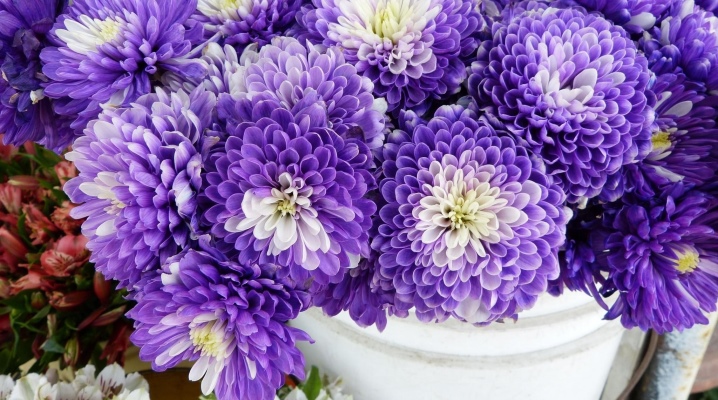
It is difficult to find a summer cottage where chrysanthemums grow, decorating the landscape from July to late autumn. To grow this flower, while maintaining its varietal qualities, you need to know some of the rules for its propagation.
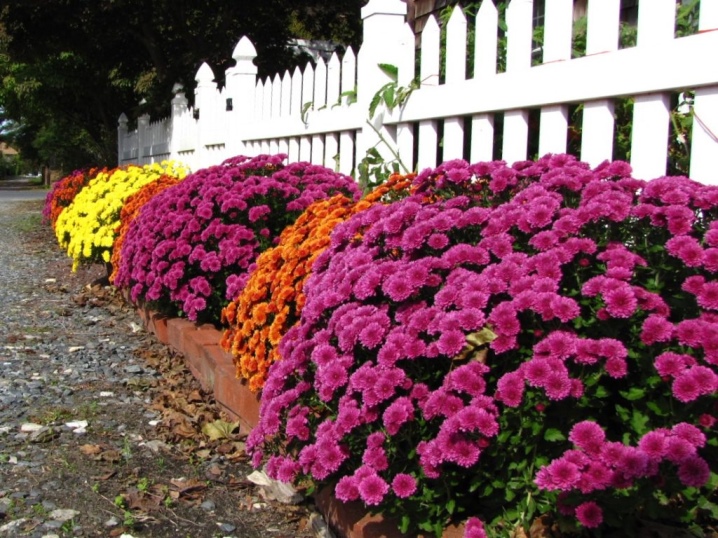
Timing
The timing is influenced, first of all, by the method chosen for the reproduction of the chrysanthemum. The timing of the planting of seeds determines the time of the beginning of its flowering. Early flowering varieties for seedlings are sown in late February or early March, and late flowering varieties are sown from 20 March to the first half of April. When planting seeds directly into the ground, sowing is carried out in May.
When grafting, the uterine bush is picked up in the fall, although the cuttings will be cut in the spring. The timing of spring cuttings also depends on the beginning of flowering: cuttings of early flowering chrysanthemums are carried out in February, middle cuttings in March, and late cuttings in early April.
However, chrysanthemum can also be propagated by cuttings in summer and autumn.
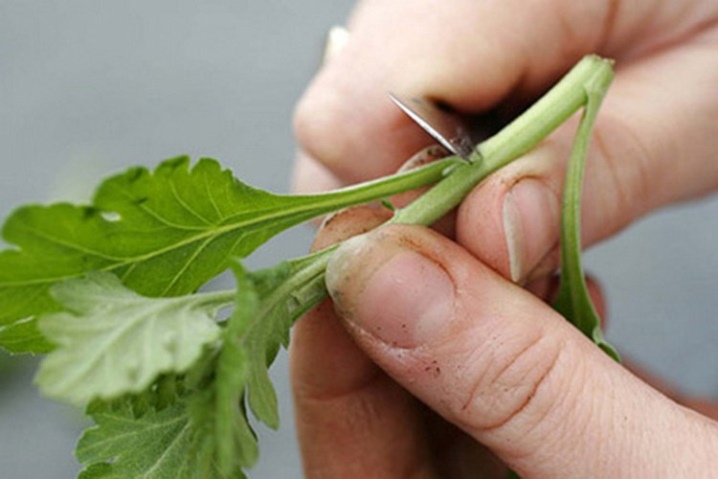
Reproduction of the plant by dividing the bush is most effective in early spring, when young shoots appear. If necessary, you can divide the bush in the summer, even during flowering. Summer division is best done in June under conditions of active plant growth or at the end of August.
Important! The timing of the reproduction of chrysanthemums is also influenced by its variety and type: it is customary to propagate single-stemmed in April, May and early June, and multi-stemmed, large and small-flowered - in March.
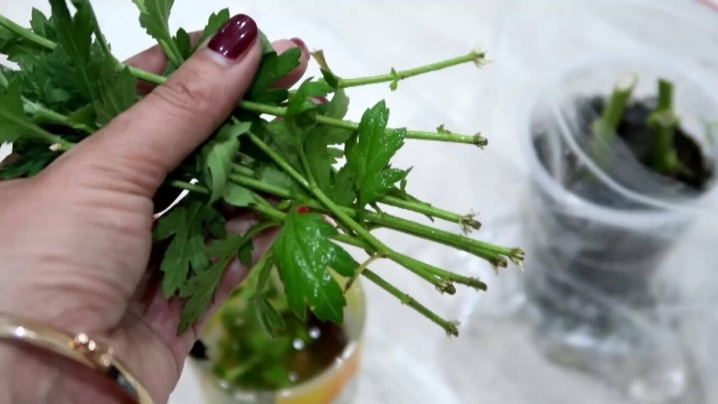
The necessary conditions
Certain conditions are necessary for successful breeding. First of all, you need to choose the right shoots for the cuttings: it must have at least 4 leaves. It is not recommended to use either too underdeveloped, or, conversely, fattening processes. Woody shoots or if the internodes on them are too close are also not suitable. In autumn cuttings, a mother bush with pronounced varietal properties in the inflorescences should be selected. The plant must be vigorous with no signs of disease or pest infestation.
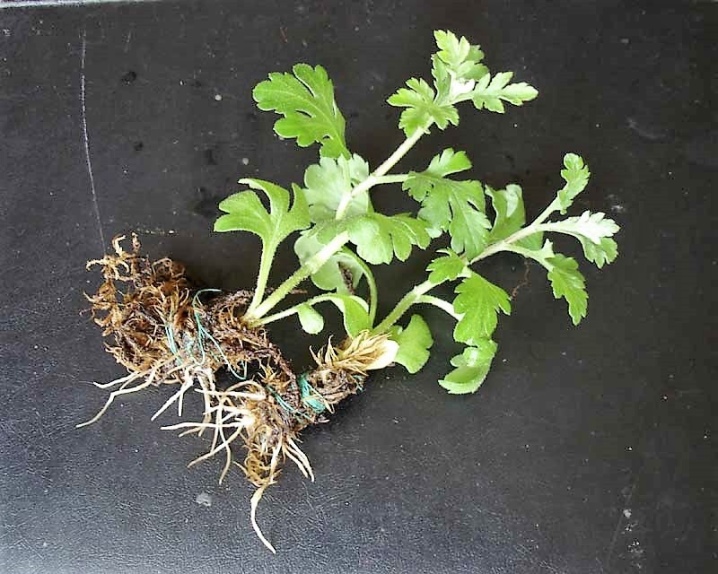
A bush dug in the fall and transplanted into a bowl should be kept in a cool room until spring. If the room has good humidity, then the mother bush does not need to be watered. Only when the soil dries up should it be slightly moistened. The best temperature regime in the room should be from +5 to +8 degrees. The effectiveness of cuttings depends on the number of young shoots. In order for them to be enough, in February the bush should be placed in a warm, well-lit place and in the future should be regularly watered.
Only those new shoots that grow from the root system are chosen for cuttings. After planting the cuttings in a separate container, they create conditions such as:
- the temperature of the content should be from +15 to +20 degrees;
- the seedlings are covered with polyethylene for 2-3 weeks until they take root; the distance from the film to the top of the cutting should be within 30 cm;
- periodically carry out water spraying (in hot weather up to 2-3 times a day);
- Feed the cuttings 2-3 times a month;
- in strong sunlight, cuttings should be shaded, especially in the first 7-10 days after planting.
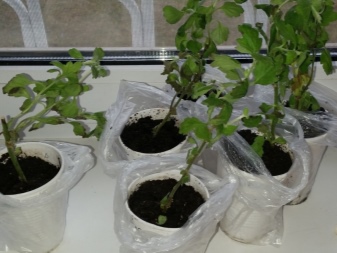

A correctly chosen place for planting seedlings in the ground is also a prerequisite for the successful reproduction of chrysanthemums. She prefers fertile soil with neutral or weak acidity. Loam is the best type of soil for plant propagation. The landing site should be well lit for at least 5 hours a day and out of reach of strong winds and drafts.
It is best to plant seedlings in cloudy weather, after rain or even in the rain.
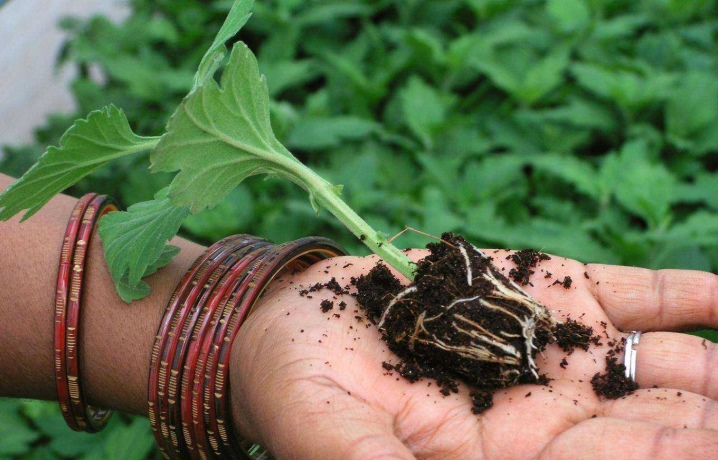
Reproduction methods
Chrysanthemum belongs to plants that have several methods of propagation. It can be propagated both at home and in open soil.
Seedling
A chrysanthemum grown by a seedling method blooms earlier than a plant bred by a seed method. Seedlings are grown at home in a warm room. First, a substrate is prepared from sod land (2 parts), humus (1 part) and peat (1 part). Previously, this mixture is sieved and steamed in an oven preheated to +110 degrees. The substrate can be replaced with ready-made store-bought soil.
The bottom of the shallow container is covered with a drainage layer (expanded clay, crushed stone). A moistened soil is placed on top, the seeds are distributed over the entire surface. The seeds of annuals are lightly sprinkled with soil, and perennials are only slightly pressed against it. Then the crops are sprayed with settled water using a spray bottle.

The container with seeds is covered with polyethylene and kept at a temperature of at least + 23– + 25 degrees. The film is removed every day (for about an hour) to ventilate and irrigate the soil, which must always be moistened. Seedlings appear in about 2 weeks, they are placed in a bright room. The airing time is gradually increased in order to adapt the plants.
In a separate container, seedlings can be planted when several real leaves appear. Only strong sprouts should be planted, weak ones are thrown away. After transplanting, the chrysanthemum is irrigated with "Zircon", "Epin-Ekstroy" or other preparations that stimulate plant growth. Seedlings are grown at home for about 1.5 months, systematically watering and fertilizing 2 times a month. It is planted in open ground only in the last days of May.
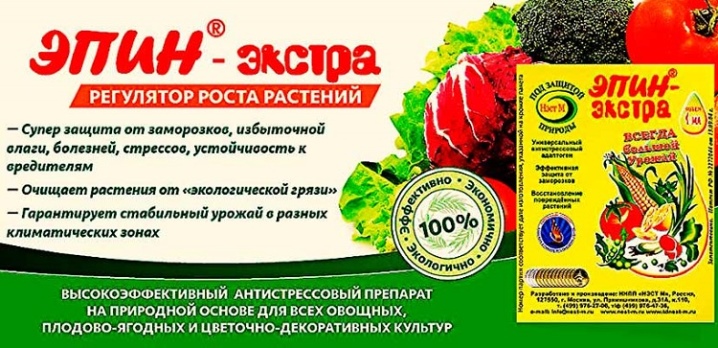
Seeds
The seed method is less effective and reliable. It is used mainly for annual and small-flowered (such as oak) varieties of chrysanthemums. Seeds are sown directly into the ground in prepared beds, in which holes are made with an interval of 20-25 cm. They are watered with warm, settled water. Several seeds are sown in one hole, which are covered with soil. From above the beds can be covered with a film for better warming up and preservation of soil moisture. The film must be removed when the first shoots appear.
In the future, the soil needs to be loosened, watered and weeds removed. After 7-10 days, the grown chrysanthemum should be fed with liquid fertilizers; the preparations "Rainbow" and "Ideal" are suitable. Thinning of sprouts is carried out when they have several true leaves. By this time, they have reached about 10 cm in height. Only one strongest and strongest sprout is left in the hole. Others can be transplanted to a separate bed.

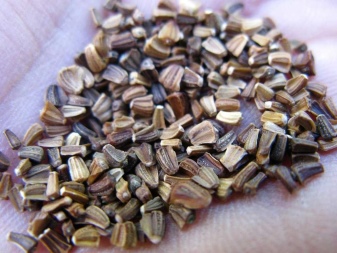
By cuttings
Cutting is the most reliable and effective method that preserves all the varietal qualities of the grown chrysanthemums. Cutting can be done in several ways.

With the help of the uterine bush
A mother bush is selected in advance - it should not be sick and with the most beautiful flowers. In the fall, at the end of flowering, all the shoots are cut off almost flush with the soil. The mother liquor is dug up and placed for the whole winter in a dark and cool place. In February, it is transplanted into fertile soil and placed in a room with a higher temperature (at least + 15 degrees). The bush is periodically watered, and after 7 days, fertilized with ammonium nitrate. If necessary, the bush is additionally highlighted.
When the mother plant grows shoots 8–10 cm high, they need to be cut off, leaving 4 leaves on the hemp. From the remaining stumps, new shoots will grow again, from which cuttings can also be cut. From the cut off processes, 2 lower leaves are removed, keeping the upper ones. For better rooting, they are treated with a solution of such stimulating drugs as "Heteroauxin", "Bioglobin", "Kornevin". Then the cuttings are planted in a container with fertile soil with a layer of about 6 cm with an interval of 3-4 cm, deepening into the ground by 2.5-3 cm. A layer (up to 3 cm) of sand or its mixture with perlite is poured on top of the soil, and then watered ... The seedlings are covered with a film, which is removed 2-3 weeks after rooting. And after another 1 week they are seated in a separate container.
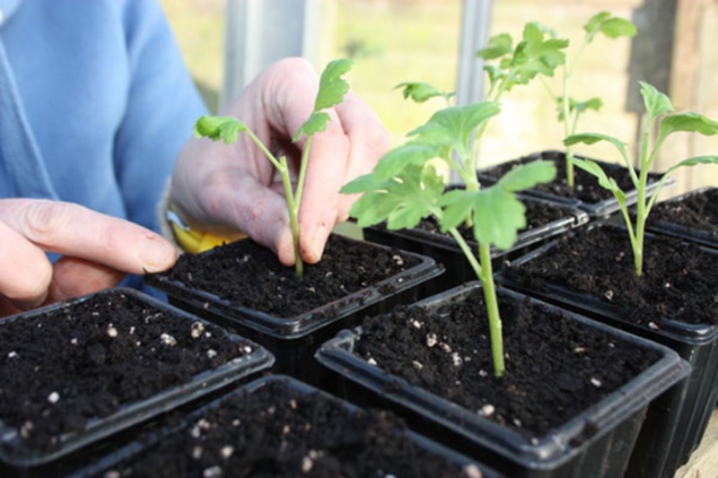
Important! To cause the growth of lateral processes, pinching should be carried out in the phase of formation of 5-6 leaves. Before planting in open soil (in about 1.5 weeks), chrysanthemums should be hardened: they are transferred to open rooms (terrace, veranda), and covered with foil at night.
Cuttings in spring in open soil
In this case, green cuttings are used, which are cut in the spring from a bush that has reached a height of 14-15 cm. They are cut from the median part of the appendix and are approximately 7 cm long. The lower leaves are cut, and at the upper leaves, half the length is cut. Cuttings are also placed in stimulants for 12 hours. Then they are planted in beds in open ground. The planted seedlings are covered with a film, which is removed in warm weather. The first roots appear after 2-3 weeks, and the shoots are formed by 5 weeks. By the beginning of June, the seedlings are already well rooted and can be transplanted to a permanent place.
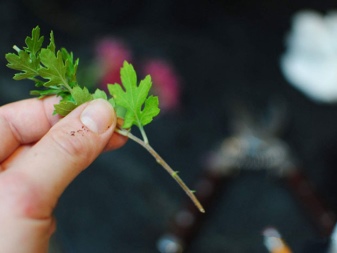
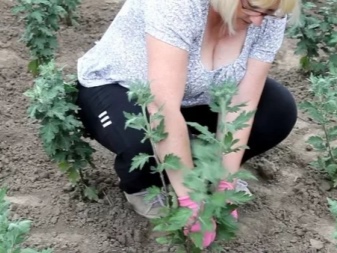
Summer cuttings
It is carried out as follows:
- for cuttings, only the young apical green parts of the plant with a soft stem are chosen; in this case, the lateral processes can also be used;
- cut off a stalk 10-15 cm long and immediately drop the cut branch into the ground in a shady place;
- in the future, they are systematically watered and irrigated with water;
- after about 20 days, the chrysanthemum takes root.
In exactly the same way, you can propagate a chrysanthemum from a bouquet. For this, the buds and inflorescences are previously removed from the cut branches. Then they are planted either in open ground, or (if it is winter) at home in bowls.
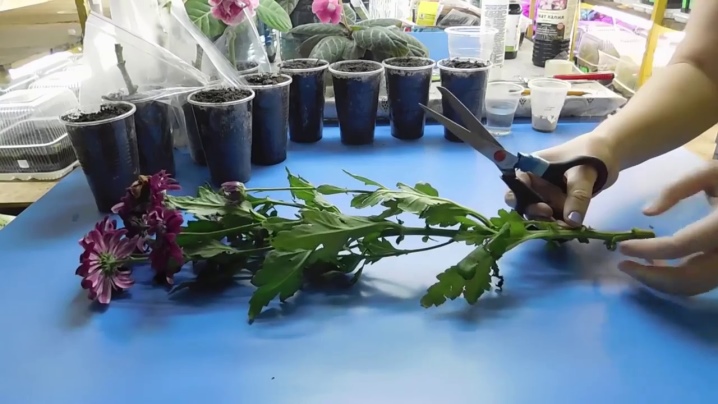
By dividing the bush
Perennial chrysanthemums can be propagated by dividing the bush. This is also an effective and popular method. It is recommended to divide the bush after 3 years. This is not only a way to propagate chrysanthemum, but also an opportunity to strengthen and heal the plant. For division, select the healthy and most developed uterine bush. It is carefully dug up, and then divided into several parts, being careful not to damage the roots. The number of parts is determined by the varietal characteristics of the chrysanthemum and its age. A three-year-old chrysanthemum can be divided into 5–6 healthy and robust parts with a good root system and ground shoots.
Parts are planted immediately in a permanent place. The planted shoots quickly take root and begin to grow actively. Care for young seedlings is the same as for adult chrysanthemums. Flowering may occur in the year of transplantation, but somewhat later than usual. If the division of the bush was carried out in the fall, then for the winter the young chrysanthemum must be covered.
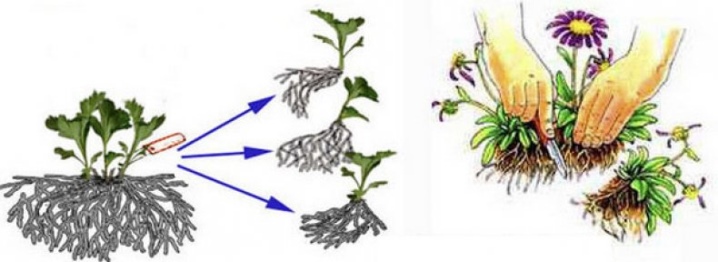
Frequent mistakes
Inexperienced gardeners often make mistakes such as:
- the uterine bush is not cut low enough, it is not recommended to leave long shoots;
- the uterine bush is stored in a warm room with a temperature significantly higher than +7 degrees, which leads to premature growth of processes;
- too short shoots are used for cuttings: underdeveloped shoots do not take root and rot;
- when planting seedlings, fresh manure is used, which is strictly prohibited, you can only use humus or compost, as well as purchased store-bought mineral fertilizers;
- dressing is applied in excess volume, which leads to the rapid formation and increase in the volume of green mass; in such plants, flowering may not occur;
- when feeding, fertilizer gets on the leaves, which can cause burns; fertilizers are applied only at the root.
Often cuttings do not take root for the following reasons:
- the cuttings have been kept in the stimulating solution for too long;
- the cuttings are placed in water, not soil;
- lack of heat or temperature fluctuations in the room where the seedlings are kept.

Florist recommendations
For beginner gardeners there will be the following recommendations of experienced florists are useful:
- in August, it is necessary to reduce watering, since the plant must prepare for winter;
- from September it is necessary to feed chrysanthemums; first of all, you need to apply organophosphate insecticides 3 times a month after 4 days;
- carry out autumn prophylaxis against pests so that insects do not settle on a bush for wintering;
- growing chrysanthemum cuttings quickly helps to root them in peat tablets;
- curb chrysanthemum requires spring pruning to form a bush: long and improperly growing branches are cut off;
- loosening and weeding of the soil under the bush should be carried out after 10-12 days, which contributes to better plant growth;
- chrysanthemums of elite large-flowered varieties must be replanted after 3 years to preserve varietal qualities.
For information on how to propagate chrysanthemum, see the video.







































































































The comment was sent successfully.